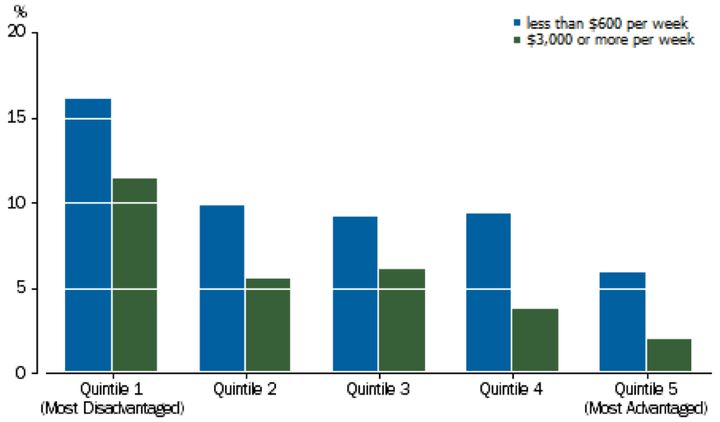By Yasmin Poole and Jake Read

Does your parents’ income matter if you are an Australian? Is the Australian system a model to copy?
This piece investigates what the Australian government is doing to improve disadvantaged accessibility to higher education. There are a range of pensions made available to students of lower and disadvantaged backgrounds. These pensions could be considered generous relative to other nations and are part of Australia’s reputation as ‘the lucky country’. In actuality, what is the welfare system for which the country is famous for?
Higher education plays a critical role in improving intergenerational economic mobility (IGM). It has been found that even from a young age, children of families which have not attended university are over one and a half academic years behind their peers. Children of higher-education families statistically receive better upbringings, due to Australia’s gap between public and private school standards.
The Australian Bureau of Statistics further found that low household income creates increased rates of children under the national minimum standards for education. As World Bank’s Fair Progress? : Educational Mobility Around the World preview report outlines, absolute upward or relative IGM increases are necessary in closing the economic mobility gap. University accessibility schemes are one element of achieving this. Increased representation in universities of the disadvantaged and lower socioeconomic backgrounds plays a core role in improving educational, economic, and employment levels of the state.

Household income directly correlates upon education levels
Australia’s successful welfare system can be largely credited for increasing disadvantaged representation in universities. The social security system itself is managed by the Department of Human Services. In this regard, social security through a system known as Centrelink represents 35% of the expenses of the Australian government at AU$159 billion (2016/17).
Payments to tertiary students are determined through parental incomes test. One of the most vulnerable stages of life is when one becomes an adult and/or leaves the family home. To make this a smoother transition for students studying after high school, Centrelink offers full Youth Allowance payments to students coming from households of AU$51 903 p.a or less. This is represented fortnightly as either AU$288.10 or AU$437.50, depending on whether you continue to live with your parents or not. For every dollar above $AU51 903, payments are reduced by AU$0.20. The system also provides optional loans such as the AU$1035 per semester Student Start-Up Loan. Consequently, this support for youth of low socioeconomic backgrounds improves accessibility for all and increases higher education rates.
Unlike some nations, tuition costs are not a factor considered by Australian youth. A successful element of Australia’s welfare system is its university tuition scheme, termed HECS-HELP. The government subsidizes domestic students’ courses through ‘Commonwealth supported places’, where most university fees are absorbed by the government. Whatever unsubsidized fees remaining are paid by the government in the form of a loan to the student, and expected to be repaid gradually (through increased income tax) once the individual earns over AU$54 869. While this means university is not free like states such as Germany or Norway, this has been critical in making higher education available to all, including individuals from indigenous, rural, disabled and even sole-parent and refugee backgrounds. It is a delicate balance between assisting students and maintaining government budget.
These schemes have and will create long-lasting impacts on future Australian generations. They encourage all domestic students to undertake higher education and provide generous means to do so. However, it should be noted that a broad-brush welfare approach will not solve all elements of the intergenerational economic mobility gap. The government has taken incremental steps to adapt its welfare initiatives for specific at-risk youths.
For example, Centrelink has introduced specific ‘Indigenous Specialist Officers’ and ‘Community Development’ job-seeking programs for indigenous welfare recipients. This adaptation to Indigenous-specific issues is a marked improvement from former welfare initiatives, which have been criticized for not respecting cultural differences. There is still more to be done for other groups, such as homeless youth, youth in foster care, or youth with mental health issues. Nonetheless, this introduction of targeted approaches is a positive step towards improving attitudes towards government initiatives, and thus education and employment as a whole.

Aboriginals and Torres Strait Islander attendance at university has slowly increased.
This piece expresses the importance of higher education for disadvantaged youths to overcome the cycle of poverty and enhance intergenerational economic mobility. Fundamentally, governments must invest in welfare to create these opportunities, leading to fair representation, empowered generations, and an equal community for all.
—
Yasmin Poole studies Laws/Arts at Monash University. Jake Read is a Commerce/International Relations student at the Australian National University.
This post is a part of a series on intergenerational mobility hosted by Friendship Ambassadors Foundation (FAF) in support of the World Bank’s #EndPoverty campaign. The views and opinions expressed in this article are those of the author and do not necessarily reflect those of FAF or the World Bank. To see all posts in the series, click here.
